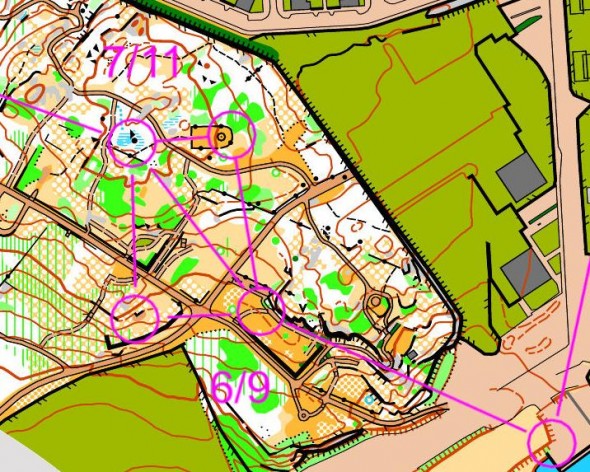
First ever World Cup victory for junior Emma Klingenberg (Denmark) – Matthias Kyburz (Switzerland) increases his overall lead in the Nordic Orienteering Tour 2012. Simone Niggli lost a lot of time in the semi-final – and did not manage to qualify for the final.
Update: You can see a replay of the KnockOut sprint on YLE (Finnish TV) here (thanks Tim).
Olav Lundanes (Norway) took the lead in the men’s race from the start – keeping everybody else behind until the start of the forking scheme. In the forking the Swedes Bergman and Lysell lost significant time – while Lundanes managed to keep the lead for most of it. Out of the forking, Tranchand (France) and Kyburz passed the Norwegian – never letting Lundanes come back up. From there and on, Kyburz simply was faster than the rest – having time to cheer wildly in the run-in. Tranchand finished second.
In the women’s class, Emma Klingenberg took the lead from the start – and never gave it away. Into the forking scheme the Danish junior managed to shake everybody off – getting on with a 8-10 seconds lead to Helena Jansson (Sweden). Klingenberg kept running fast and orienteering well – and could take an easy victory 5 seconds ahead of Tatiana Riabkina with Judith Wyder in 3rd.
Clear leaders
In the overall Nordic Orienteering Tour standings, Simone Niggli is still in a clear lead – although Helena Jansson reduced the lead down to 2:46. Judith Wyder in third is at 3:14. In the men’s class it is more open – with Kyburz being 1:27 ahead of Olav Lundanes with Thierry Gueorgiou in third at 1:59. With a sprint on Friday – Kyburz’s speciality – followed by middle chasing start on Saturday – nothing is yet decided.
Results
Women
| 1 | Emma Klingenberg | 17 | DEN | 10:05 | 0 |
| 2 | Tatyana Ryabkina | 22 | RUS | 10:10 | 5 |
| 3 | Judith Wyder | 8 | SUI | 10:11 | 6 |
| 4 | Helena Jansson | 1 | SWE | 10:13 | 8 |
| 5 | Minna Kauppi | 14 | FIN | 10:14 | 9 |
| 6 | Merja Rantanen | 5 | FIN | 11:09 | 1:04 |
| 7 | Anastasiya Tikhonova | 21 | RUS | 11:39 | 1:34 |
| 8 | Tove Alexandersson | 19 | SWE | 12:39 | 2:34 |
Men
| 1 | Matthias Kyburz | 101 | SUI | 09:28 | 0 |
| 2 | Frédéric Tranchand | 117 | FRA | 09:32 | 4 |
| 3 | Peter Öberg | 102 | SWE | 09:41 | 13 |
| 4 | Eskil Kinneberg | 118 | NOR | 09:43 | 15 |
| 5 | Olav Lundanes | 122 | NOR | 09:46 | 18 |
| 6 | Jerker Lysell | 113 | SWE | 09:50 | 22 |
| 7 | Øystein Kvaal Østerbø | 119 | NOR | 09:52 | 24 |
| 8 | Gustav Bergman | 116 | SWE | 10:21 | 53 |
Overall NORT standings
(Note: There seem to be some small errors in the overall standings, but it is correct for the top places)
Women
| Name | Stage 1 | Bonus 1 | Stage 2 | Stage 3 | Bonus 3 | Tour time | Diff | |||
1  Simone Niggli Simone Niggli |
13:26 | 2:00 | 29:09 | 14:59 | 0:11 | 55:23 | ||||
2  Helena Jansson Helena Jansson |
13:20 | 0:50 | 31:44 | 14:55 | 1:00 | 58:09 | 2:46 | |||
3  Judith Wyder Judith Wyder |
14:03 | 0:16 | 30:28 | 15:32 | 1:10 | 58:37 | 3:14 | |||
4  Anne Margrethe Hausken Nordberg Anne Margrethe Hausken Nordberg |
13:56 | 1:10 | 32:34 | 14:56 | 0:36 | 59:40 | 4:17 | |||
5  Minna Kauppi Minna Kauppi |
13:33 | 0:18 | 31:33 | 15:53 | 0:55 | 59:46 | 4:23 | |||
6  Ida Bobach Ida Bobach |
14:19 | 1:00 | 31:36 | 15:10 | 0:12 | 59:53 | 4:30 | |||
7  Lina Strand Lina Strand |
13:49 | 0:34 | 31:05 | 15:58 | 0:10 | 01:8 | 4:45 | |||
8  Merja Rantanen Merja Rantanen |
14:41 | 0:34 | 31:42 | 15:25 | 0:50 | 01:24 | 5:01 | |||
9  Tove Alexandersson Tove Alexandersson |
13:19 | 0:50 | 32:39 | 16:01 | 0:36 | 01:33 | 5:10 | |||
10  Tatyana Ryabkina Tatyana Ryabkina |
15:04 | 0:13 | 31:00 | 16:13 | 1:30 | 01:34 | 5:11 | |||
11  Maja Alm Maja Alm |
14:11 | 0:15 | 32:49 | 15:32 | 0:34 | 01:01:43 | 6:20 | |||
12  Sara Lüscher Sara Lüscher |
14:14 | 0:02 | 32:26 | 16:03 | 0:15 | 01:02:26 | 7:03 | |||
13  Tone Wigemyr Tone Wigemyr |
14:26 | 0:30 | 32:34 | 16:17 | 0:14 | 01:02:33 | 7:10 | |||
14  Ines Brodmann Ines Brodmann |
14:59 | 0:55 | 33:04 | 15:38 | 0:09 | 01:02:37 | 7:14 | |||
15  Sabine Hauswirth Sabine Hauswirth |
14:26 | 0:36 | 32:23 | 16:27 | 01:02:40 | 7:17 | ||||
16  Sofia Haajanen Sofia Haajanen |
14:45 | 0:12 | 32:37 | 15:49 | 0:18 | 01:02:41 | 7:18 | |||
17  Venla Niemi Venla Niemi |
14:29 | 0:03 | 32:00 | 16:29 | 01:02:55 | 7:32 | ||||
18  Anastasiya Tikhonova Anastasiya Tikhonova |
14:31 | 0:17 | 33:15 | 16:12 | 0:40 | 01:03:01 | 7:38 | |||
19  Annika Billstam Annika Billstam |
13:51 | 0:38 | 34:43 | 15:47 | 0:32 | 01:03:11 | 7:48 | |||
20  Silje Ekroll Jahren Silje Ekroll Jahren |
15:20 | 32:18 | 15:47 | 0:13 | 01:03:12 | 7:49 |
Men
1  Matthias Kyburz Matthias Kyburz |
13:32 | 1:30 | 30:06 | 18:23 | 2:00 | 58:31 | ||||
2  Olav Lundanes Olav Lundanes |
13:16 | 2:00 | 30:15 | 19:22 | 0:55 | 59:58 | 1:27 | |||
3  Thierry Gueorgiou Thierry Gueorgiou |
13:41 | 0:36 | 29:00 | 18:41 | 0:16 | 01:30 | 1:59 | |||
4  Peter Öberg Peter Öberg |
14:28 | 0:15 | 29:42 | 18:26 | 1:10 | 01:01:11 | 2:40 | |||
5  William Lind William Lind |
14:20 | 1:10 | 30:33 | 18:29 | 0:09 | 01:02:03 | 3:32 | |||
6  Gustav Bergman Gustav Bergman |
13:47 | 0:50 | 30:37 | 19:11 | 0:36 | 01:02:09 | 3:38 | |||
7  Matthias Merz Matthias Merz |
14:09 | 0:55 | 30:29 | 18:54 | 0:10 | 01:02:27 | 3:56 | |||
8  Carl Waaler Kaas Carl Waaler Kaas |
13:54 | 0:18 | 30:35 | 19:25 | 0:36 | 01:03:00 | 4:29 | |||
9  Øystein Kvaal Østerbø Øystein Kvaal Østerbø |
14:23 | 1:00 | 31:04 | 19:17 | 0:40 | 01:03:04 | 4:33 | |||
10  Jonas Leandersson Jonas Leandersson |
13:53 | 0:17 | 31:12 | 18:36 | 0:11 | 01:03:13 | 4:42 | |||
11  Tue Lassen Tue Lassen |
14:34 | 0:38 | 30:09 | 19:20 | 0:08 | 01:03:17 | 4:46 | |||
12  Fabian Hertner Fabian Hertner |
14:03 | 0:15 | 31:06 | 18:43 | 0:15 | 01:03:22 | 4:51 | |||
13  Eskil Kinneberg Eskil Kinneberg |
13:51 | 0:10 | 31:48 | 19:15 | 1:00 | 01:03:44 | 5:13 | |||
14  Frédéric Tranchand Frédéric Tranchand |
14:49 | 0:40 | 32:11 | 19:14 | 1:30 | 01:04:04 | 5:33 | |||
15  Mattias Karlsson Mattias Karlsson |
14:16 | 0:34 | 30:42 | 19:44 | 01:04:08 | 5:37 |
Maps
Impressions from the TV broadcast
For those of you who did not have the possibility to see the TV broadcast, below are a few screenshots giving you a feeling about how it was.
How would you change the KnockOut sprint?
This was the third time a KnockOut sprint was on the World Cup program – and both the forking and an improved TV production compared to previous editions made it quite interesting for the viewers. Several steps forwards for the KnockOut sprint format – but it is still a very open question if this is the future for orienteering. Unfortunately SVT Play did not work internationally as advertised up front, so many orienteering fans could not follow the broadcast (and no live TV/webTV broadcast from the semi-finals). However, as pointed out in the comments, you can watch a replay of the KnockOut sprint on YLE here.
Two years ago – before the first KnockOut sprint – Jørn Sundby said the following about the KnockOut sprint format:
– The competition shall be a fight man against man with tactics as the main element. Routechoices shall be decisive, and runners who are ahead with their orienteering shall have an advantage. With as few as six runners in the heats, forking could be unfair because it could decide the race, and the lucky ones could come behind the best in “their” forking and earn time on it. With unforked courses everybody has the same chances.
KnockOut with Forking
This year forking was introduced. From a fairness point of view there has already been some discussion about the fairness of the forking as it was claimed that the ones with the long forking first could run on the back of the others. However, when looking at the GPS tracking, it looks like the time lost on the forking was just as much about not taking ideal route choices than about unfairness due to the forking in itself .
And although the fairness of the chosen forking scheme may be discussed, it brought another element into the race – making it more interesting for the viewers. From the start of the forking it started to get interesting to watch.
Assuming the KnockOut-sprint is to stay on the orienteering calendar – how would you change the format? I think introducing “blind controls” (i.e. other controls close to the ones in use) and also removing control codes from the controls (making it necessary to be more careful with the orienteering) would make it more interesting both for runners and for TV. The controls could then be like “easy trail-o controls” – making the orienteering element more important. With a map exchange you could even make fair forking in this way. I know – this sounds like Micr-o all over again – but still …
 World of O News
World of O News

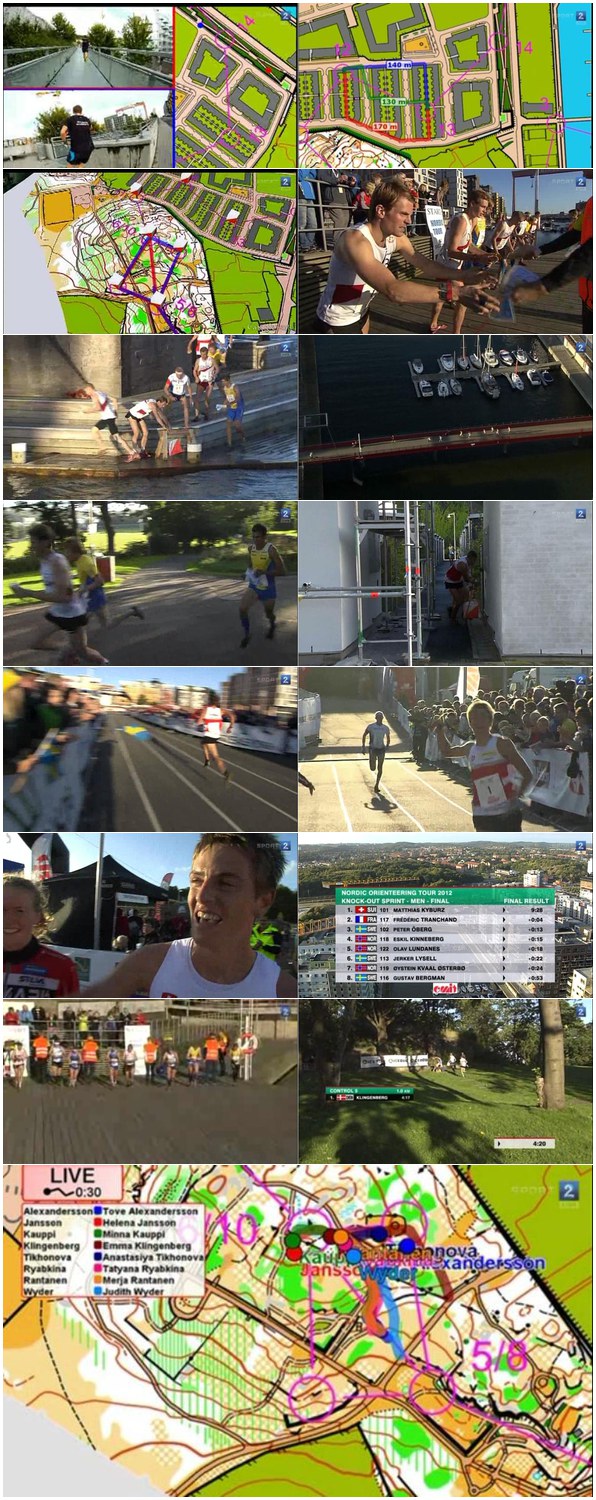
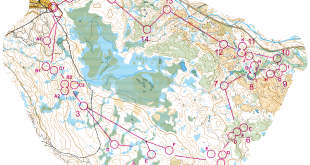
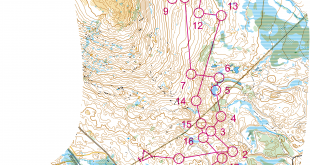
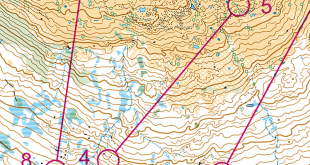
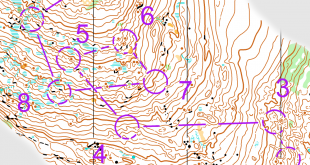
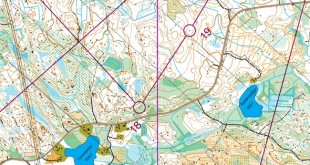
Forking seemed to work very well (based on the GPS) in both the men’s and women’s semi 3…
… but maybe not in the finals …
Any feedback from the runners?
The replay of YLE`s broadcast from Göteborg. First there is little summary from Oslo. KnockOut starts after about 12,5 minutes. http://areena.yle.fi/tv/1628019
I was watching GPS tracking and one thing which should be improved is text (name of runner) which is attached to each dot. It was impossible to see the area. It would be batter to have text pop up each 30s or so.
About the TV production: Yes, it was difficult to see who which dot belonged to. It was partially the same problem also on the middle distance on Sunday when we showed 3-4 runners together from the start. Two techniques can be used in GPSSeuranta currently ; either highlight selected runners like in this clip http://www.youtube.com/watch?v=vH0-cVsP8d8 – or the same kind of highlight which changes from runner to runner every second. It is not easy when so many runners are shown at the same time though… When GPS-tracking is shown for only 10-20 seconds, having text popping up every 30 seconds would not help much …
If you wath in GPSSeuranta itself, you can make the text smaller or even turn it on/off to see the map (if that was the question?)
I didn’t know that but I was thinking more about what should be the default option. I think the option without names, only dots as default option might be better because you already have names in the right corner. And if I would be interested to know who is who I would like to know that only 2-3s after each CP.With real split times window inside the GPS tracking window this could be good for someone who is able to watch only GPS tracking.
From GPS dots I thought that Tranchand won the race.
Hi! What was the reason to remove one stage (1/4 final) and increase number of runners (from 6 to 8)??
In my opinion it creates a real mass (especially during first punching and in case of narrow passages).
Route choices was nice. In case of good route choices we don’t need to create forking, because strong runners just will be easy spread out in these situations.
I run yesterday in semifinals and performed really badly. I haven’t been a great fun of knock out sprint and this time didn’t change that. Although I think it was partly knock out middle distance. If it’s supposed to be sprint, control points should be easier.
The best knock out sprint is the race, where both running (well) in the front and orienteering well are rewarded. Tactics with following others and speeding up in the end should be made more difficult to implement successfully. More important it is to be in the front more aggressive and interesting is the race. I think eight men is good amount of runners in the heat as well as two punching units. It makes it more important to be near the front.
Courses should be both technical and include route choices. If there are lots of corners and some narrow passages, it’s more important to be near the front. Technical courses also increase possibility to do orienteering errors. If there is made mistake in the front, those who orienteer carefully benefit. If there are route choices, then it’s possible to try own choice.
The easiest way to do such a course is to use many controls. If there are long route choice legs, then there are usually technically easy parts where physically strongest runners are able to come in the front. It’s better to have multiple shorter route choice legs. I think that end part of semifinals was way too easy. If runners were together by the railway bridge, the strongest runners found their way in the front quite easily and by orienteering well you couldn’t win many seconds.
We ran a knock out sprint in Finland’s NORT qualifications. I think those courses were the best knock out sprint course I have seen so far. Situation during races was chancing quite a lot and many different route choices were taken. Courses can be found: http://www.jrv.fi/kisaharveli/cgi-bin/reitti.cgi?act=map&id=2&kieli= and http://www.jrv.fi/kisaharveli/cgi-bin/reitti.cgi?act=map&id=4&kieli=
I think if a course is good, forking is not needed.
Thanks for good input! Shorter routechoice legs sounds like a good idea – but it might be more difficult to adapt to TV both due to camera range and poorer GPS tracking performance.
However, I agree that more technical challenges = more is happening = more interesting for both viewers and runners…